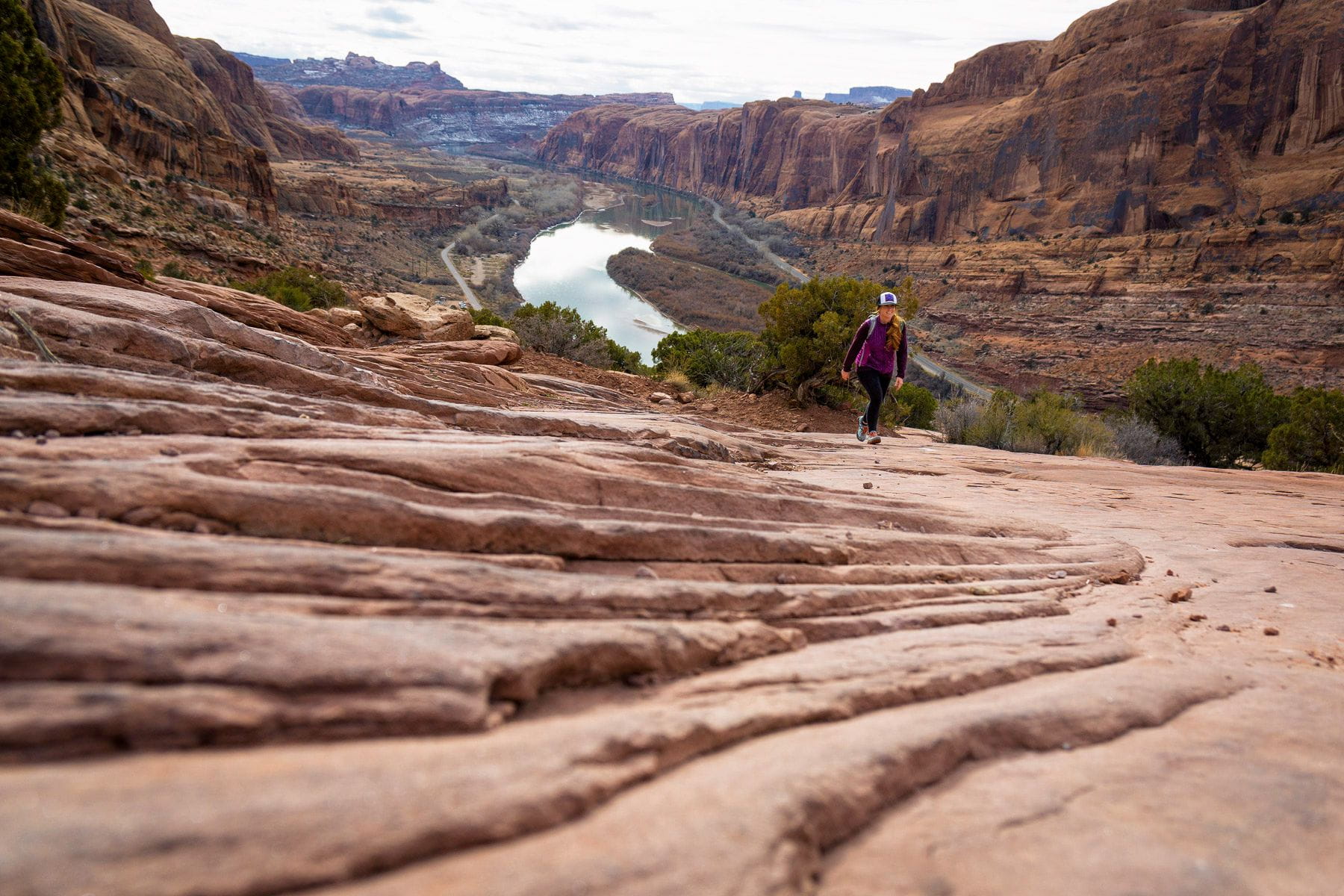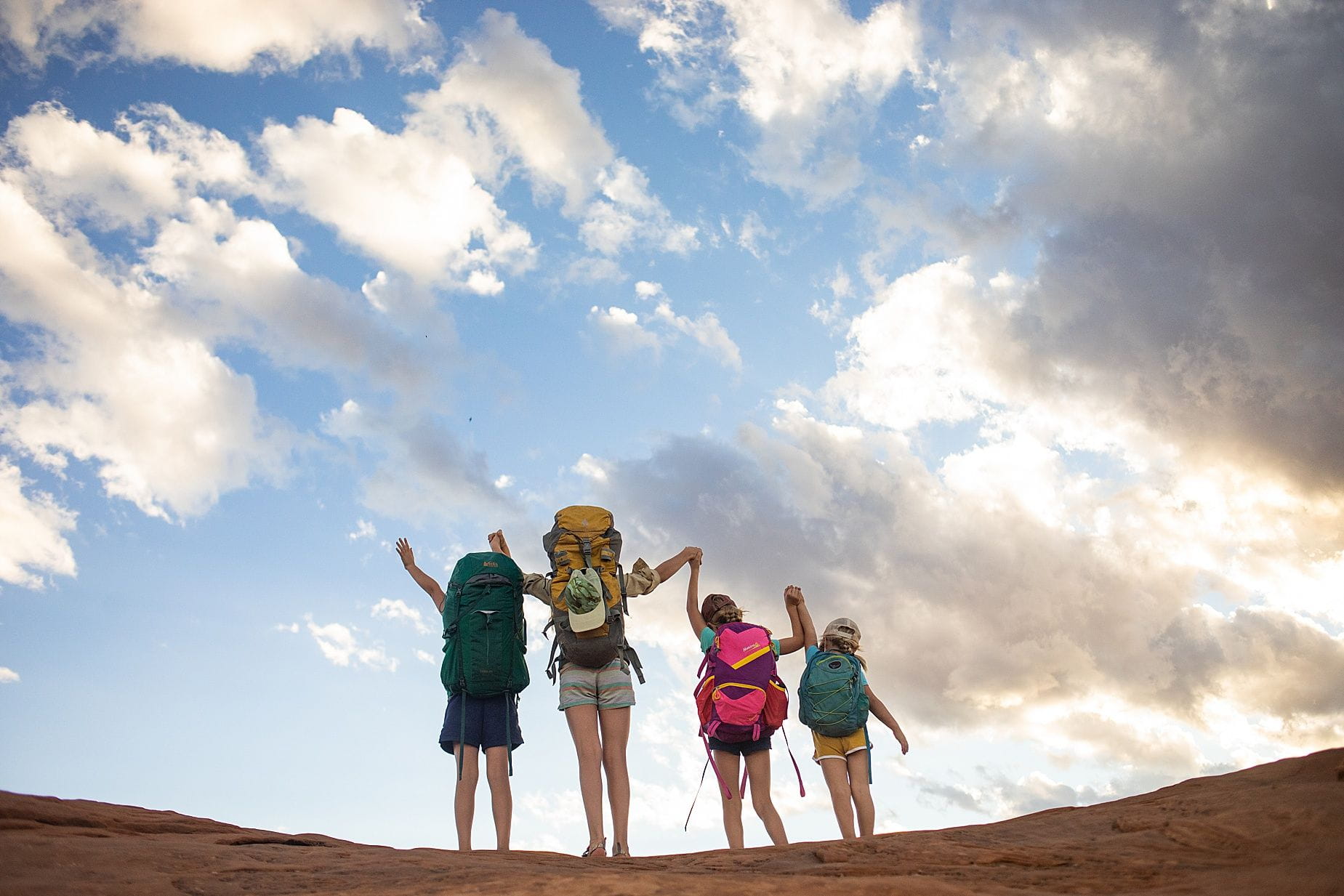Hiking – Moab

Please also read our Know Before You Go and Desert Tips for more really important tips.
Be Prepared
No matter how short your hike is, always carry water! Also have a good backpack with food, a rain jacket, sunscreen, a whistle, headlamp, a map (the old-fashioned paper kind!), a compass, and a first-aid kit. Maps are available at the Moab Information Center or state and national parks.
Hydration and Nutrition
Take water, at least a gallon a day per person. Yes, a gallon. The air is incredibly dry so it will dehydrate you quickly. A pack with a built-in hydration bladder is the optimal choice. Take plenty of snacks and food. Sports bars, dried fruit and nuts, or the trusty peanut butter and jelly sandwich, are popular choices. Coconut water is great to help with hydration and recovery after a big day.
Don’t Go it Alone
Do not hike or climb alone. Stay away from cliffs and watch your footing. Handholds on sandstone can be brittle.
Make It Known
Always tell someone where you are going and when you plan to return. When you do get back, let them know. The Moab area has the highest rate of search-and-rescue operations in Utah.
Don’t Rely on Your Cell
Cell service is spotty, at best, so don’t rely on your phone to work. Popular topo and map apps will drain your phone’s battery. If you are using an app as your only map, don’t. When your phone dies, you will not know how to find your way back, or use your phone to call for help, if needed. Carry a printed map and know how to use it.
Choose Wisely
Choose your hike, not only according to your fitness level, but also your comfort level. You will have more fun if you’re within your limits. Many desert hikes require scrambling skills and can be terrifying if you have a fear of heights. Also, it’s much easier to climb up something steep than to come down it, so don’t put yourself in a bad position.
Happy Feet
If your feet are happy, the rest of your body will be happy. Sturdy footwear with traction is essential: hiking boots, beefy running shoes, or river shoes if your hike requires water crossings.
Wear a good pair of wicking socks, made of wool or a synthetic, not cotton. Carry an extra pair of socks.
First Aid
Have a basic first-aid kit in your pack. Visit any local outfitter store to find a kit that will suit your needs. Band aids, athletic tape, and a bandana are good basics. Make sure to include a portable waste bag/WAG bag or two.
Pet Friendly
Pets are allowed on most trails (though not in any national park). All dogs must be kept under verbal restraint and not be a public nuisance nor chase or harass wildlife. A leash is required on all BLM trails. Be smart near exposed ledges. Always pick up after your dog and pack it out with you.
The Call of Nature
If nature calls while you are hiking or camping in a primitive area, you must have a WAG bag. This is now the law! The desert is way too fragile to handle leaving or burying human waste. And, no one wants to find it! Human waste takes about a year to biodegrade. With more and more people visiting the area, the use of these bags is crucial.
Really, they are not that bad to use. Bags are small and lightweight so they are the perfect addition to your pack, or even for your car. Once used, close the bag tightly and put it in the bottom of your pack. The WAG bags include a solidifying agent which breaks down and deodorizes waste.
Once you have used your bag (good up to four uses), you must dispose of them in a WAG bag-only trash can. This is important because they are more heat resistant than regular trash cans.
Purchase WAG bags at one of our partners: Arches National Park Bookstore, Canyonlands National Park Bookstore, Moab Information Center, GearHeads Outdoor Store, and Wild West Voyages.
Stay on the Trail
Biological soil crust looks unremarkably like dirt, but it’s actually a self-sustaining biological unit that is essential to the health of the desert ecosystem. Always stay on the trail to avoid damaging this vital part of the desert.
Trail Markers
The trail often disappears or becomes hard to see, so trail markers are built.
A cairn (Gaelic for rock mound) acts as your trail marker. Cairns are placed by those who built or maintain the trails. Follow the cairns and stay on the trail.
Don’t add to any cairns or create your own. They can cause confusion and can even be dangerous.
A Good Pack
A backpack that contains the proper supplies is really important for your day of hiking. Invest the time to find a good pack that fits you and is comfortable.
The following list may seem big for a simple hike, but you never know. Don’t skimp on being prepared.
Essentials To Have With You
- Whistle (To get someone’s attention in an emergency.)
- Headlamp/Extra Batteries
- Shelter/Trash Bag
- WAG Bags
- Sun Protection
- Knife/Repair Kit
- Physical Map
- First-Aid Kit
- Nutrition/Hydration (a gallon a day!)
- Extra Clothes, Light Jacket, Extra Socks
- Garmin or emergency device (The iPhone 14 (and later models) has emergency SOS capabilities that uses satellites instead of cell towers).
Gear Up

GearHeads has all sorts of backpacks, water bottles, socks, clothing, and shoes. Fill up all your water containers for free. 435-259-4327, MoabGear.com.
Walker Drug has all sorts of great hiking gear. 435-259-5959, WalkerDrug.com.
Go with the Pros
If this is your first time hiking in the desert, or you want to explore a new place, hire a guide for your group. Not only will you be safe, but a local guide knows all the cool places to explore.
NAVTEC Expeditions offers 4x4/hiking tours, including Lavender and Davis Canyons in The Needles. 435-259-7983, Navtec.com.
Wild West Voyages offers private half- and full-day guided hikes and van tours around the Moab area and in both Arches and Canyonlands National Parks. Discover the desert’s varied terrain, including open trail, narrow canyons, soaring arch vistas, desert landscapes, fascinating geology, dinosaur tracks, and ancient rock imagery. 435-238-4257, WildWestVoyages.com.
San Juan County
This area has many incredible hiking destinations. Some hikes are easy and right off the road. Others take a bit more work and determination. All need to include respect for the area and any artifacts you may see along the way.
Please visit these areas with respect and practice Leave No Trace ethics while exploring. Cell phone reception is limited, so don’t rely on mobile phone use. Have a map and know how to read it.
A BLM permit is required for most day hiking and backpacking activities in these areas. Some destinations require permits in advance and have quotas, while some you can simply get a day-use permit at the trailhead with no quotas. Some trailheads have a $5 fee. Carry some $1 dollar bills in your pack to have for the fee envelope.
It’s highly recommended you get your permits in advance at Recreation.gov.
The Kane Gulch Ranger Station is located on Utah Hwy 261 about four miles from Utah Hwy 95. Open for permits and questions 8am-noon only March 1-June 15 and Sept. 1-Oct. 31.
The Needles district of Canyonlands National Park has some amazing hikes. Visit NPS.gov/Cany.
Go With The Pros
To truly enjoy this area, take a guided hike by Ancient Wayves River and Hiking Adventures. This indigenous-owned outfitter provides fun, guided adventures in the Bears Ears area with focus on culture sharing and native interpretation. 505-239-8505, TourAncientWayves.com.
Wild Expeditions leads private hikes to ancient dwellings and rock panels that go at your pace. They focus on teaching respect to the sites and to the land. 435-280-2557, RiversAndRuins.com.